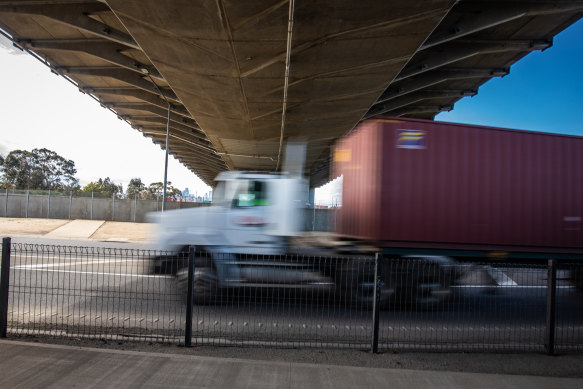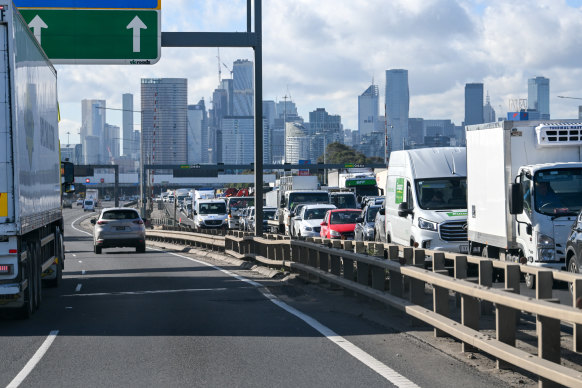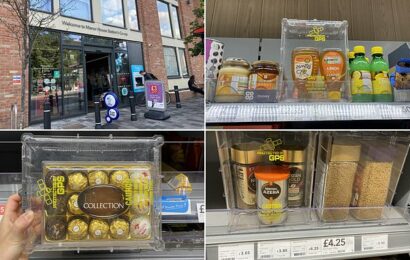Save articles for later
Add articles to your saved list and come back to them any time.
Melbourne’s skies usually look pretty clear, so you might be tempted to think that air pollution is not a problem. But you’d be wrong.
Air pollution caused by truck exhaust causes at least 400 deaths in Australia each year. Truck exhaust pipes spew out fine particulate matter and nitrogen oxide, which cause asthma, coronary heart disease, strokes, bladder cancer, and type-2 diabetes. Children are particularly vulnerable to air pollution – including in the womb.
Air pollution caused by truck exhaust causes at least 400 deaths in Australia each year.Credit: Scott McNaughton
If trucks are continually rumbling down your street, you’re at greater risk of illness, and it builds over time. Even low levels of pollution can damage your health, but long-term exposure increases your risks.
In Melbourne, we’ve got a problem in the west. The City of Maribyrnong includes many major truck routes, and it has an adolescent asthma rate 50 per cent higher than the state average. Maribyrnong’s hospital admission rate is more than 70 per cent higher than the Australian average for people aged three to 19, and the inner west has a higher incidence of lung cancer than the general Australian population. The suburbs of Yarraville and Brooklyn are ranked seventh and eighth in Australia for their air pollution concentration.
The biggest culprit is old trucks. Until 1996, trucks sold in Australia did not need to meet any pollution standards. These old trucks emit at least 60 times more fine particulate matter than trucks that meet current standards, and about eight times as much nitrogen oxide. Even when Australia did introduce pollution standards, they were initially very weak because the technology at the time was nowhere near where it is today.
Very old, very dirty trucks make up a large share of our truck fleet because Australians hold onto trucks for a lot longer than owners in other countries. The average age of a truck in Australia is 15 years, about twice the average age of a truck in Europe. There are trucks on our roads that are more than 40 years old, and more than 14 per cent of Australian trucks were manufactured before 1996. Another 12 per cent were manufactured between 1996 and 2002. This means that more than a quarter of the Australian fleet has not been required to satisfy any more than the most minimal pollution standards.
Truck exhaust pipes spew out fine particulate matter and nitrogen oxide.Credit: Eddie Jim
Electric trucks will be great when they arrive – but at present, only 0.03 per cent of heavy vehicles in Australia are electric. Even for cars, only 0.5 per cent are electric so far. It’s going to be a long time before electric vehicles make much of a dint in the problem of air pollution.
And while we wait, huge numbers of heavy diesel trucks will continue to rumble through Melbourne’s west at all hours of the day and night. Footscray residents are deeply concerned that A-doubles are allowed to hammer down residential streets like Moore Street 24/7. Some truck operators in the Brooklyn and Tottenham areas have been exempted from curfews since 2015. Delays to the completion of the West Gate Tunnel mean that trucks will not be banned from residential streets until the new completion date of 2025.
Of course, dealing with this problem isn’t easy. There’s a balance to be struck between the needs of the community and the needs of businesses involved in building the West Gate Tunnel – which will, when completed, take trucks off local roads. But the problem is that children and other vulnerable people are breathing in poisonous fumes right now.
What’s needed is to keep the oldest and dirtiest trucks away from densely populated areas. About 20 per cent of Melbourne’s trucks are pre-2003, and they’re the ones that do by far the most damage. The government should ban this 20 per cent of trucks, not just from the area around the port, and the construction site of the West Gate Tunnel, but from the entire metro area of Melbourne, where millions of people live. It’s not that the remaining 80 per cent of trucks do no harm at all, but it’s far less.
This may sound radical, but hundreds of cities around the world do this, and their residents breathe much more freely as a result.
For the sake of all Melburnians – but especially for the children growing up in the west – we should ban old, polluting trucks from our city.
Marion Terrill is director of the transport and cities program at Grattan Institute, and lead author of The Grattan truck plan: Practical policies for cleaner freight (2022).
The Opinion newsletter is a weekly wrap of views that will challenge, champion and inform your own. Sign up here.
Most Viewed in National
From our partners
Source: Read Full Article









